![]()
![]()
![]()
Use LEFT and RIGHT arrow keys to navigate between flashcards;
Use UP and DOWN arrow keys to flip the card;
H to show hint;
A reads text to speech;
63 Cards in this Set
- Front
- Back
|
What are the types of eating disorders?
|
- Anorexia nervosa
- Bulimia nervosa - Binge eating disorder - Avoidant / restrictive food intake disorder - Other specified eating disorder - Unspecified eating disorder |
|
|
Case 1:
- 16 yo Caucasian girl w/ history of depression and anxiety (treated w/ SSRI) - Parents are concerned about weight loss - Started dieting 6 months ago: initially cut out snacks, limits desserts, and started running; started avoiding fats and carbs; only eats 200-500 calories/day - Insists on prepping her own food and makes elaborate food for others - Isolated from friends and avoids situations involving food - Lost 20 lbs and BMI of 16, wants to lose 10 more lbs - 4.0 GPA wants to go to med school, figure skater, active in school clubs - No interest in dating, not sexually active, no alcohol/drug use - Fam Hx: mother has anxiety, aunt has eating disorder - Last menstrual period 6 months ago What is the diagnosis? a) Disordered eating b) Eating disorder not otherwise specified c) Anorexia nervosa d) Obsessive compulsive disorder e) Avoidant/restrictive food intake disorder |
Anorexia Nervosa
|
|
|
What does "anorexia" mean?
|
Loss of appetite (but this is not true of anorexia nervosa - they do have an appetite)
|
|
|
What characterizes Anorexia Nervosa?
|
Disturbance in body image and intense pursuit of weight loss
|
|
|
What are the DSM IV diagnostic criteria for Anorexia Nervosa?
|
• A. Weight loss to less than 85% of ideal body weight or failure to make expected weight gains in children and adolescents
• B. Intense fear of gaining weight • C. Disturbance in how one perceives their body • D. Amenorrhea for 3 months in postmenarcheal females |
|
|
What are the changes to DSM 5 for the diagnostic criteria for Anorexia Nervosa?
|
• A. Removal of less than 85 percentile of IBW criteria → “significantly low weight”
• B. Intense fear of gaining weight or behaviors that interfere with weight gain • C. Unchanged • D. Removed the amenorrhea criteria |
|
|
What are the subtypes of Anorexia Nervosa?
|
- Restricting type
- Binge-eating / purging type |
|
|
What are the signs of the Binge/Purge type of Anorexia Nervosa?
|
• Eating a large amount of food in a short period of time
• Engaging in compensatory behavior to get rid of the food or weight • Feelings of loss of control during the episode |
|
|
Why is Anorexia Nervosa so important to diagnose?
|
It is the most lethal psychiatric disorder (don't ignore weight loss in teenager patients)
|
|
|
What are the physiologic effects of starvation?
|
Vital sign changes
– Hypotension – Bradycardia – Hypothermia |
|
|
How do you treat Anorexia Nervosa?
|
Refer patient for inpatient medical stabilization
|
|
|
Which organs are affected by Anorexia Nervosa?
|
• Dermatology: Lanugo (fine baby-like hair over the body)
• Cardiac: Syncope, arrhythmias and sudden death • Endocrine: Cold intolerance, amenorrhea (decreased LH, FSH, and estradiol) • Hematologic: anemia, leucopenia • Skeletal: Osteopenia/Osteoporosis • Neurologic: Reduction in brain mass volume and cognitive deterioration |
|
|
What happens dermatologically in Anorexia Nervosa?
|
Lanugo (fine baby-like hair over the body)
|
|
|
What are the cardiac changes in Anorexia Nervosa?
|
Syncope, arrhythmias and sudden death
|
|
|
What are the endocrine changes in Anorexia Nervosa?
|
Cold intolerance, amenorrhea
(decreased LH, FSH, and estradiol) |
|
|
What are the hematologic changes in Anorexia Nervosa?
|
Anemia, leucopenia
|
|
|
What are the skeletal changes in Anorexia Nervosa?
|
Osteopenia/Osteoporosis
|
|
|
What are the neurologic changes in Anorexia Nervosa?
|
Reduction in brain mass volume and cognitive deterioration
|
|
|
What happens when a patient with Anorexia Nervosa starts getting refed?
|
Refeeding Syndrome:
- Syndrome of clinical complications that occur as a result of fluid and electrolyte shifts during nutritional rehabilitation of severely malnourished patient. - Refeeding too quickly can lead to hypophosphatemia and potentially life threatening arrhythmias. - Risk of refeeding syndrome is directly related to the amount of weight lost during the current episode and the rapidity of weight restoration. |
|
|
How is most commonly affected by Anorexia Nervosa?
|
- More often in females
- 10% in males - Usually onset is in mid-teens, though recent trends towards pre-pubescent development - 1% of population w/ 5% showing subclinical signs |
|
|
What causes Anorexia Nervosa?
|
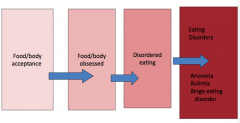
Multifactorial
- Different in every patient - Dieting is #1 risk factor - Biopsychosocial formulation |
|
|
What are the biological factors contributing to Anorexia Nervosa?
|
• Higher rates in monozygotic twins
• Strong family history for mood disorders – Biochemical changes (norepinephrine, endorphin increases, starvation effects) • Associated with onset of puberty |
|
|
What are the psychological factors contributing to Anorexia Nervosa?
|
• Temperament – perfectionist, harm avoidant
• Maturation fears |
|
|
What are the social factors contributing to Anorexia Nervosa?
|
• Media influence
• Obesity education (need to emphasize health not weight) • Family concerns about weight • Dieting information • Teasing about weight • Performance pressures in sports |
|
|
Who are the components of the team that treats a patient with Anorexia Nervosa?
|
- Primary care physician
- Psychiatrist - Dietician - Family therapy, individual therapy, group therapy |
|
|
Which meds can help treat Anorexia Nervosa?
|
• No medications have consistently shown benefit for the core symptoms of eating disorders (ED)
• Medications are generally used to treat psychiatric comorbidities |
|
|
What are the approaches to therapy used to help patients with Anorexia Nervosa?
|
• “Maudsley” Family Based Treatment (family is in control of what patient eats)
• Cognitive behavioral therapy (CBT) to address cognitive distortions • Dialectical behavioral therapy (DBT) to address treatment interfering behaviors |
|
|
Case 2:
- 21 yo college female presents w/ spells of binge eating followed by obsessive need to rid herself of calorie she just ate - Behaviors include self-induced vomiting, excessive exercising, and using diet pills and laxatives - Previously 20 lb overweight but currently at a normal weight, although she believes she is very overweight - Swollen cheeks and abrasions on her left knuckles What is the diagnosis? |
Bulimia Nervosa
|
|
|
What does "Bulimia Nervosa" mean?
|
Voracious appetite or constant hunger, again a misnomer because it is characterized by episodes of overating and compensatory behavior to prevent weight gain
|
|
|
What are the DSM-IV criteria for diagnosing Bulimia Nervosa?
|
• A. Recurrent episodes of binge eating followed by inappropriate compensatory behavior in order to prevent weight gain
• B. Episodes occur at least twice a week for 3 months • C. Self evaluation is unduly influenced by body shape and weight • D. The disturbance does not occur exclusively during anorexia nervosa • Subtypes: purging type and non-purging type |
|
|
What is considered purging?
a) Restrictive dieting/skipping meals b) Binge-eating c) Nausea d) Routine exercise e) Laxatives |
Laxatives
(also diuretics, enemas, vomiting) |
|
|
What are the changes to DSM-5 criteria for diagnosing Bulimia Nervosa?
|
A. Recurrent episodes of binge eating
B. Recurrent inappropriate compensatory behavior in order to prevent weight gain C. Episodes of A and B occur at least once a week for 3 months D. Self evaluation is unduly influenced by body shape and weight E. The disturbance does not occur exclusively during anorexia nervosa • Subtypes were removed • Severity can be specified: based on number of episodes/week |
|
|
What are the clinical signs of Bulimia Nervosa?
|
• Swollen cheeks
• Russel’s signs: abrasions on knuckles from scraping against teeth • Front teeth that are chipped or ragged and “moth-eaten” • Dental erosions and caries • Damagetotheesophagus • Cardiac arrhythmias and myopathies • Fluid and electrolyte imbalance |
|
|
Why do patients with Bulimia Nervosa have swollen cheeks?
|
Parotid gland hypertrophy or infection
|
|
|
What is Russel's sign?
|
Abrasions on knuckles from scraping against teeth
|
|
|
What signs would you expect on the teeth of a patient with Bulimia Nervosa?
|
- Front teeth: chipped or ragged and "moth-eaten"
- All teeth: erosions and cavities |
|
|
What are common laboratory abnormalities associated with purging?
a) Serum glucose abnormalities b) Low serum amylase c) Hypernatremia d) Hypokalemia e) Hyperlipidemia |
Hypokalemia
|
|
|
What are the most common abnormalities associated with vomiting?
|
- Metabolic alkalosis (low potassium, low sodium, elevated bicarbonate)
- Hypokalemia - Hypochloremia - Hyperchloremic metabolic acidosis (low potassium, elevated chloride, low bicarbonate) due to laxative use - Elevated serum amylase level - No significant blood sugar abnormalities - The highest levels of cholesterol are in patients with anorexia who also binge-purge |
|
|
Which Eating Disorder patients have the highest levels of cholesterol?
|
Patients with anorexia who also binge-purge
|
|
|
What are the implications of hypokalemia in patients who excessively vomit?
|
Excessive vomiting leads to loss of K+ → potentially lethal arrhythmias
|
|
|
How should you treat patients who are purging more than 3x/day?
|
Refer for inpatient evaluation (may have metabolic abnormalities)
|
|
|
How common is Bulimia Nervosa?
|
- More common than Anorexia Nervosa (>3% of population)
- Onset is later than Anorexia Nervosa (lat adolescence / early adulthood) - Surveys of college women found up to 40% report binging and purging |
|
|
How can Bulimia Nervosa be treated pharmacologically?
|
- More responsive to serotonin fluctuations
- SSRI antidepressant medications have been shown to be effective (eg, Fluoxetine) |
|
|
What is the typical temperament of a patient with Bulimia Nervosa?
|
- Overachiever
- Competitive secretive - Ego dystonic - Self-critical |
|
|
What behaviors / disorders is Bulimia Nervosa associated with?
|
- Depression
- Alcohol use disorders - Impulse control disorders - Emotional lability - History of abuse |
|
|
What are the social factors that contribute to Bulimia Nervosa?
|
- Media influence
- Anti-obesity education - Weight teasing / bullying |
|
|
How do you treat Bulimia Nervosa?
|
Meds:
- SSRI anti-depressants Therapy: - Cognitive Behavioral Therapy (CBT) - Dialectical Behavioral Therapy (DBT) - Family Therapy - Group Therapy |
|
|
What are the diagnostic criteria for Binge-Eating Disorder?
|
• A. Recurrent episodes of binge eating
– Eating in a discrete period of time more than most people would – Sense of lack of control • B. Binge eating episodes are associated with 3+ of – More rapid eating, feeling uncomfortably full, eating large amounts of food when not feeling hungry, eating alone due to embarrassment, feeing disgusted/depressed/guilty after • C Marked distress regarding eating binge eating • D. Occurs once per week for 3 months • E Not associated with recurrent use of inappropriate compensatory behavior, and not exclusively during bulimia nervosa or anorexia nervosa • Same severity scale as bulimia nervosa |
|
|
What are the diagnostic criteria for Avoidant / Restrictive Food Intake Disorder?
|
• A. Persistent failure to meet appropriate nutritional/energy needs with one of:
– Significant weight loss or failure to gain expected weight – Significant nutritional deficiency – Dependence on enteral feeding or oral supplements – Marked interference with psychosocial functioning • B. Not better explained by lack of food or cultural practice • C. Not part of anorexia nervosa or bulimia nervosa and not associated with a disturbance in the way one’s body weight/shape is experienced • D. Not attributable to a concurrent medical condition or other mental disorder, or beyond what one would expect for another condition/disorder |
|
|
What are the other specified eating disorders?
|
• Atypical anorexia nervosa (i.e. normal weight)
• Bulimia nervosa of low frequency or limited duration • Binge-eating disorder of low frequency or limited duration • Purging disorder • Night eating syndrome |
|
|
What are the unspecified eating disorders?
|
Other feeding and eating symptoms that cause clinically significant distress or impairment in social, occupational or other important areas of functioning, or having insufficient information to make a more specific diagnosis
|
|
|
Disordered Eating:
- Consumed by thoughts? - Restricted diet? - Distorted body image? - Low weight? - Binge-eating? - Purging? |
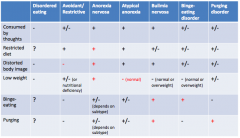
- Consumed by thoughts: -
- Restricted diet: ? - Distorted body image: - - Low weight: - - Binge-eating: ? - Purging: ? |
|
|
Avoidant / Restrictive Eating Disorder:
- Consumed by thoughts? - Restricted diet? - Distorted body image? - Low weight? - Binge-eating? - Purging? |
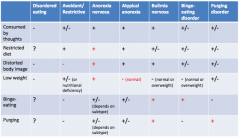
- Consumed by thoughts: +/-
- Restricted diet: + * Distorted body image: - - Low weight: +/- (or nutritional deficiency) - Binge-eating: - - Purging: - |
|
|
Anorexia Nervosa
- Consumed by thoughts? - Restricted diet? - Distorted body image? - Low weight? - Binge-eating? - Purging? |
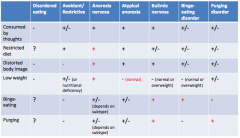
- Consumed by thoughts: +
* Restricted diet: ++ * Distorted body image: ++ * Low weight: ++ - Binge-eating: +/- (depends on subtype) - Purging: +/- (depends on subtype) |
|
|
Atypical Anorexia:
- Consumed by thoughts? - Restricted diet? - Distorted body image? - Low weight? - Binge-eating? - Purging? |
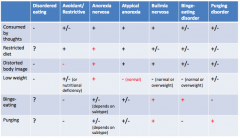
- Consumed by thoughts: +
- Restricted diet: + - Distorted body image: + * Low weight: - (normal) - Binge-eating: +/- - Purging: +/- |
|
|
Bulimia Nervosa:
- Consumed by thoughts? - Restricted diet? - Distorted body image? - Low weight? - Binge-eating? - Purging? |
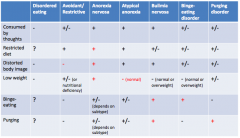
- Consumed by thoughts: +
- Restricted diet: +/- - Distorted body image: + - Low weight: - (normal or overweight) * Binge-eating: + * Purging: + |
|
|
Binge-Eating Disorder:
- Consumed by thoughts? - Restricted diet? - Distorted body image? - Low weight? - Binge-eating? - Purging? |
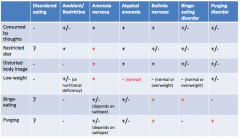
- Consumed by thoughts: +/-
- Restricted diet: +/- - Distorted body image: +/- - Low weight: - (normal or overweight) * Binge-eating: + - Purging: - |
|
|
Purging Disorder:
- Consumed by thoughts? - Restricted diet? - Distorted body image? - Low weight? - Binge-eating? - Purging? |
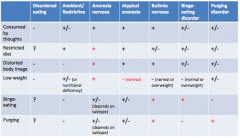
- Consumed by thoughts: +/-
- Restricted diet: +/- - Distorted body image: +/- - Low weight: +/- - Binge-eating: - * Purging: + |
|
|
What is the definition of obesity?
|
– Obesity: weighing >20% ideal body weight (IBW) or having a body mass index (BMI) of 30+
– Overweight: BMI 25-29.9 |
|
|
How common is obesity?
|
– > 1/3 of US adults are obese
– Increasingly children are overweight/obese |
|
|
Significantly low weight is a criterion for which of the following?
a) Anorexia nervosa b) Bulimia nervosa c) Both d) Neither |
Anorexia Nervosa
|
|
|
Normal appetite occurs in which of the following eating disorders?
a) Anorexia nervosa b) Bulimia nervosa c) Both d) Neither |
Both
|
|
|
Purging behaviors may occur with which of the following eating disorders?
a) Anorexia nervosa b) Bulimia nervosa c) Both d) Neither |
Both
|

